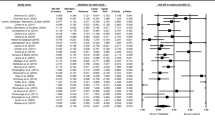Abstract
Background and aims
Various studies assessed rates of post-traumatic stress disorder (PTSD) following natural disasters including earthquakes. Yet, samples were often non-representative or small or both. This study aims to assess the prevalence of PTSD and predictors of PTSD 6 months after an earthquake in a rural region of Italy.
Methods
A questionnaire was handed out to a representative sample of approximate 3,000 people in the region of Molise in Italy 6 months after an earthquake in October/November 2002. The questionnaire assessed socio-demographic characteristics, aspects of the event, the experience of symptoms immediately after the earthquake, and symptoms of PTSD.
Results
Questionnaires of 2,148 people were returned, representing a response rate of 73.7%. The final analysis was based on 1,680 people. The screening tool provided a PTSD prevalence rate of 14.5%. Male gender, age under 55 years, and better school education predicted lower rates of PTSD. More variance was explained when psychological symptoms of immediately after the event were also included as predictors.
Conclusion
The findings on predictors are consistent with the literature. Whilst personal characteristics explain only a small variance of PTSD six months after the event, early psychological distress allows a better prediction of who is likely to have PTSD 6 months later.
Similar content being viewed by others
References
Anderson KM, Manuel G (1994) Gender differences in reported stress response to the Loma Prieta earthquake. Sex Roles 30:725–733
Bland S, Valoroso L, Stranges S, Strazzullo P, Farinaro E, Trevisan M (2005) Long-term follow-up of psychological distress following earthquake experiences among working Italian males: a cross-sectional analysis. J Nerv Ment Dis 193(6):420–423
Bödvarsdottir I, Elklit A (2004) Psychological reactions in Icelandic earthquake survivors. Scand J Psychol 45(1):3–13
Bremner JD, Southwick S, Brett E, Fontana A, Rosenheck R, Charney DS (1992) Dissociation and posttraumatic stress disorder in Vietnam combat veterans. Am J Psychiatry 149:328–332
Breslau N, Davis GC, Andreski P (1996) Risk factors for PTSD-related traumatic events: a prospective analysis. Am J Psychiatry 152:529–535
Breslau N, Peterson EL, Kessler RC, Schultz LR (1999) Short screening scale for DSM-IV posttraumatic stress disorder. Am J Psychiatry 156(6):908–911
Carr VJ, Lewin TJ, Webster RA, Kenardy JA, Hazell PL, Carter GL (1997) Psychosocial sequelae of the 1989 Newcastle earthquake, II: exposure and morbidity profiles during the first 2 years post-disaster. Psychol Med 27:167–178
Chang CM, Connor KM, Lai TJ, Lee LC, Davidson JR (2005) Predictors of posttraumatic outcomes following the 1999 Taiwan earthquake. J Nerv Ment Dis 193(1):40–46
Goenjan AK, Najarian LM, Pynoos RS, Steinberg AM, Manoukian G, Tavosian A, Fairbank LA (1994) Posttraumatic stress disorder in elderly and younger adults after the 1988 earthquake in Armenia. Am J Psychiatry 151:895–901
Karanci AN, Rustemli A (1995) Psychological consequences of the 1992 Erzican (Turkey) earthquake. Disasters 19:8–18
Kato H, Asukai N, Miyake Y, Minakawa K, Nishiyama A (1996) Post-traumatic symptoms among younger and elderly evacuees in the early stages following the 1995 Hanhin-Awaji earthquake in Japan. Acta Psyciatr Scand 93:477–481
Kessler RC, Sonnega A, Bromet E, Hughes M, Nelson CB (1995) Posttraumatic stress disorder in the national co-morbidity survey. Arch Gen Psychiatry 52:1048–1060
Lai TJ, Chang CM, Connor KM, Lee LC, Davidson JR (2004) Full and partial PTSD among earthquake survivors in rural Taiwan. J Psychiatr Res 38(3):313–322
Lewin TJ, Carr VJ, Webster RA (1998) Recovery from post-earthquake psychological morbidity: who suffers and who recovers? Aust NZ J Psychiatry 32(1):15–20
Montazeri A, Baradaran H, Omidvari S, Azin SA, Ebadi M, Garmaroudi G, Harirchi AM, Shariati M (2005) Psychological distress among Bam earthquake survivors in Iran: a population-based study. BMC Public Health 11(5):4
Murray J, Ehlers A, Mayon RA (2002) Dissociation and post-traumatic stress disorder: two prospective studies of road traffic accident survivors. Br J Psychiatry 180:363–368
Nolen-Hoeksema S, Morrow J (1991) A prospective study of depression and post-traumatic stress symptoms after a natural disaster: the 1989 Loma Prieta earthquake. J Pers Soc Psychol 6:115–121
Önder E, Tural Ü, Aker T, Kiliç C, Erdoğan S (2006) Prevalence of psychiatric disorders three years after the 1999 earthquake in Turkey: Marmara earthquake survey (MES). Soc Psychiatry Psychiatr Epidemiol 41:868–874
Peen J, Dekker J, Schoevers RA, ten Have M, Graaf R, Beekman AT (2007) Is the prevalence of psychiatric disorders associated with urbanization? Soc Psychiatry Psychiatr Epidemiol 42:984–989
Phifer JF (1990) Psychological distress and somatic symptoms after natural disaster: differential vulnerability among older adults. Psychol Aging 5:412–420
R Development Core Team. R: a language and environment for statistical computing. R Foundation for Statistical Computing, Vienna, Austria, 2005. URL http://www.r-project.org. ISBN 3-900051-07-0
Silove D, Steel Z, Bauman A, Chey T, McFarlane A (2007) Trauma, PTSD and the longer-term mental health burden amongst Vietnamese refugees. Soc Psychiatry Psychiatr Epidemiol 42:467–476
Solomon SD, Davidson JRT (1997) Trauma: prevalence, impairment, service use and cost. J Clin Psychiatry 58(Suppl 9):5–11
Strollo A, Richwalski SM, Parolai S, Gallipoli MR, Mucciarelli M, Caputo R (2007) Site effects of the 2002 Molise earthquake, Italy: analysis of strong motion, ambient noise, and synthetic data from 2D modelling in San Giuliano di Puglia. Bull Earthquake Eng 5:347–362
Author information
Authors and Affiliations
Corresponding author
Rights and permissions
About this article
Cite this article
Priebe, S., Grappasonni, I., Mari, M. et al. Posttraumatic stress disorder six months after an earthquake. Soc Psychiat Epidemiol 44, 393–397 (2009). https://doi.org/10.1007/s00127-008-0441-y
Received:
Revised:
Published:
Issue Date:
DOI: https://doi.org/10.1007/s00127-008-0441-y




